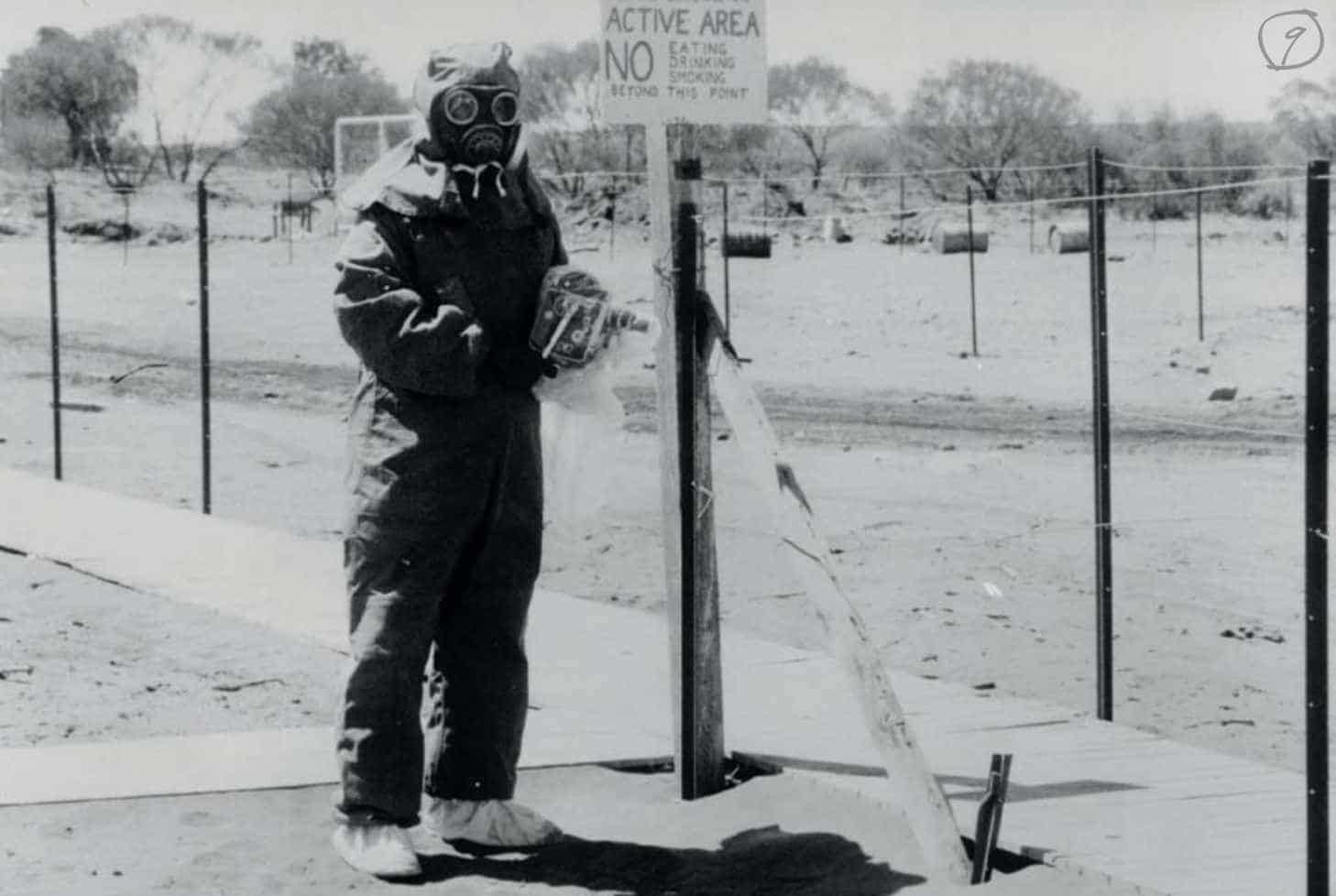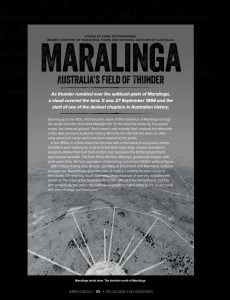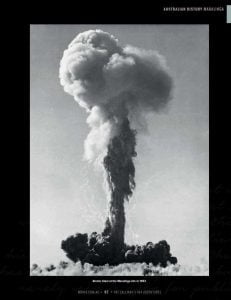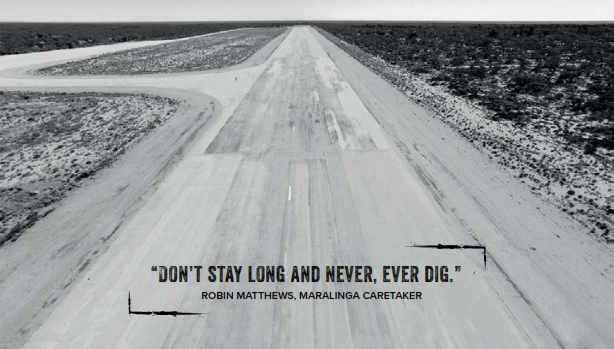Your cart is currently empty!

Pat Callinan’s 4×4 Adventures magazine article

Maralinga – Australia’s Field of Thunder
As thunder rumbled over the saltbush plain of Maralinga a cloud covered the land, it was the 27th September 1956 and the start of one of the darkest chapters in Australian history.

Growing up in the 80s, I first became aware of the existence of Maralinga through the words of iconic rock band Midnight Oil ‘In the wind the ashes fly, the poison crown, the charcoal ground’, but it wasn’t until recently that I realised the aftermath of this dark period in Australian history. Recently the site that has been so often sung about but rarely seen is open for public view.
In the 1950s, at a time when the cold war was raging, the British were looking for a place to test their long-range missiles and atomic weapons, and rather than test in their own backyard the British government approached Australia. The than Prime Minister, Menzies, granted permission.
With military testing sites already underway at Emu Fields and Woomera, outback surveyor Len Beadell was given the task of finding a suitable location closer to the railway. On reaching South Australia’s large expanse of sparsely inhabited red desert on the edge of the Nullarbor he wrote ‘We all knew immediately that this was going to be the place, the saltbush undulations rolled away as far as we could see, even through our binoculars’.
Within days Beadell’s men set to work, their Land Rovers dragging lengths of railway for a temporary runway, roads were forged and, within a week, supplies started arriving from the UK. The village of Maralinga designed to house 2000 servicemen was created and an area the size of England was securely fenced off. Aptly named after the Yolngu Indigenous peoples word for thunder, the notorious history of Maralinga was about to begin.
On the 27th September 1956 at the dusty site called One Tree, the wind had died down and the countdown began for the start of Operation Buffalo. Five, four, three, two, one, boom, Maralinga’s first mushroom cloud swelled over the saltbush country of South Australia.

Over the next thirteen months explosions at Marcoo, Kite, Breakaway, Tadje, Biak and Taranaki took place, seven major nuclear tests in total. But some of the worst contamination of the area was a result of the countless minor tests in the early 1960s which left behind radioactive and toxic chemicals including plutonium, uranium and beryllium.
Until 1978 for the most part the Australian public were unaware of the testing program taking place at Maralinga, with elements of the program shrouded in secrecy. And today many young Australians have never heard of Maralinga, few know the history of the blasts that shattered the local indigenous community and forced aboriginal people away from their traditional lands. Reports claim that aboriginal people were injured and killed by the testing and that generations of children have been still born or born with health problems.
The testing program at Maralinga sparked one of the most shameful episodes in Australian history when under a cloak of secrecy and without the knowledge of family, the bones of more than 21,000 bodies, many babies and children, were harvested and underwent tests for the presence of the radioactive substance Strontium-90. The tests were conducted to determine the effects of the atomic fallout, particularly the effect on the food chain, cows feeding in fall out areas were believed to contain the dangerous substance in the milk they produced. The experiments continued for over 20 years and only recently has some of the information reached the public.
Decades later the true and full extent of the damage caused by the testing program at Maralinga to service personnel and local communities is unknown. In 1967 the British abandoned Maralinga leaving behind a contaminated landscape. After numerous clean-ups and millions of dollars the area was finally deemed safe to visit.
Much of the Maralinga village has been demolished and streets now wind past concrete slabs where houses once stood. Built with the intention of the program operating for 30 years, the village had all the facilities to accommodate the long-term occupation including a post office, chapel, cinema, barber, football fields and, for some relief from the intense summer heat, a swimming pool. Only six original buildings remain including the former hospital.
The long bitumen airstrip is long enough to land an Airbus and said to be strong enough to land the space shuttle. The centrepiece of the site is ground zero, the site where atomic bombs as powerful as Hiroshima were exploded and where over the eerie barren ground, life still struggles to regenerate.
In 2014 almost sixty years after the first atomic test at Maralinga, rehabilitation work was completed and the final parcel of the land was handed back to the traditional owners, the Maralinga Tjarutia people.
With the permission of the Maralinga Tjarutia people, guided tours of the site commenced in April 2015. The site has been developed for visitors with a camping ground, amenities and museum. Hundreds of kilometres of secure perimeter fencing surround the site and visitors are greeted at the locked gate by the tour guide and caretaker Robin Matthews.
‘Not Kazakhstan, not Nevada… but South Australia’s Maralinga’ reads the tourism slogan of Maralinga Tours and like the infamous nuclear testing sites of the US and Soviet Union, Maralinga too has a story to tell. Buried under the dust is a forgotten chapter in Australian history and for those ready, the secrets are waiting to be uncovered.
Getting there:
Access to the site is only available through Maralinga Tours and tours must be pre-booked.
From Nundroo to Maralinga: About 27km west of Nundroo a sealed road heads north, there are no signs advertising the destination, as you continue along as expected in this remote location the road turns to dust. Across the Trans-Australian Railway near Ooldea you once again hit sealed road, an unusual presence in this remote location and a testament to the program that took place here. 225km from Nundroo you reach Maralinga Village.
Access to Maralinga is not permitted via Emu Road, but if you’re looking for a bit more dust and adventure you can travel between Maralinga and the Anne Beadell Highway with permission. From Volkes Hill on the Anne Beadell Highway follow Cook Road and turn off towards Oak Valley via the private Lake Dey-Dey Road to Maralinga. Permits are required and the fee generally waived if the Maralinga tour is booked.
Tania Ketteringham

Download a pdf of the article, courtesy Pat Callinan’s 4×4 Adventures